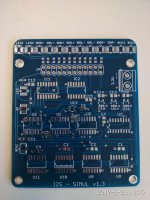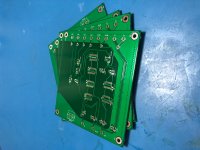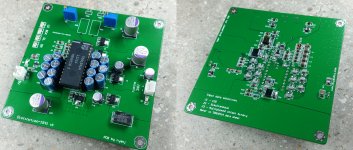maxlorenz,
you should write poems rather than design amplifiers.
I think he is happy doing both.
no doubt this is obvious to all but me, but a re read of some earlier material on this thread caused me to reconsider I/V resistor value. I noticed John's earlier references to sub 30r resistor values so I replaced 60r value with 30r on a single 1541a setup using simple resistor I/V into a tube buffer.
Two positive outcomes. Eliminated some harshness which I assume was distortion. Also attenuated the output volume by an estimated 9db (three clicks on my linestage). My system had too much gain. High compression tracks were loud even at minimum volume. Now everything sounds natural and at a more useful volume.
Thanks as always for the encyclopedia of useful material here.
I am using also Riv from lower values, and I can agree with You about sound outcome. Only it is very low signal and have to be amplified. Good old vacuumtube will do the job... Bare in mind that signal is out-of-phase at the Riv, next gain stage if it is single ended (JFET or TUBE) shift phase again to in-phase. Cheers
Thanks Max. Same and more on the 1541a. I wind my own with manganin. Nothing else compares. I started with metal film; then carbon; the audio note vintage tantalum stuff; amtrans(dreadful); Caddok TF-USF (quite good)…
Then made my own... night and day difference. Also used them in the tube output stage. Similar benefit.
Walter
You can try Graphite too for that lower values 2-3 pieces in series will be OK?
(I did not test it like Riv only in loudspeaker crossover, and it was better than other types)
But try anyway to measure with precise ohm meter.
.
Maybe it is not bad idea to test Graphene? But it is not easy to obtain...
Last edited:
maxlorenz,
you should write poems rather than design amplifiers.
True poets receive inspiration from above.
I am not that lucky, but by coincidence, I started recently an interest in poetry while reading "Les Vers Dorés de Pithagore" from Fabre D' Olivet a wise man from France...you remember Pitagoras, right. These old wise men trained both hemispheres from the old tool, in order to perfect it to become a better seat for the Mind. Not like today when only one set of skills are develloped...
Les vers dores de Pythagore, expliques, et traduit pour la premiere fois en vers eumolpiques francais; preecedes d'un discours sur l'essence et la forme de la poesie, chez les principaux peuples de la terre ... par FabreD'Olivet : Antoine Fabre d'Olivet : Free Download, Borrow, and Streaming : Internet Archive
Most said poets are "versificators" only, anyway.
And I wouldn't say I "design" amplifiers...I just copied someone else's work.
Best wishes,
M.
Max,
You are a poet in DIY audio. I have followed your posts for years and am thrilled by pictures of your DIY gear with cotton insulated conductors, hand wound resistors and point to point wiring. There is no doubt you produce some great sounding gear.
Oh! I am very touched by your kindness.
 I am not worthy, Non sum dignus, Domine.
I am not worthy, Non sum dignus, Domine.Nothing beats kindness. Nothing can resist it.
I know I know almost nothing, but I try, as you probably do, to share, form the heart, and I do apologise in advance for all the nonsense that I could have shared in all these years, in good faith...I hope nobody got killed or invalid form those...
And no, as I learn more tricks, also my listening capabilities evolve and are refined so I find artificial reproduction all the more questionable...at least I found dynamics again in my improbable amp experiment, which caused some comments above from people so much able than my humble self and who could contribute so much to the advancement of the Art if only...
And talking about cotton and air and enamelled wires, it seems to me that dielectrics are not a point of interest as should be in the dielectric world.
Best wishes to all my fellow humans,
Cordially yours,
M,
Hi aive
That noise is as expected without the 100u caps in place. The 50hz ripple is not being filtered out and is appearing at the output as the noise you are hearing.
As usual, you were right. I initially installed 8 x 100 u caps, sound persisted, so I was doubtful. But then mouser order arrived and I got the remaining ones installed, hum is completely gone!
When listening with headphones, I still get a little distortion at low sound levels, even after 10 mins or so. But it's not noticeable with speakers so I'm ok with that.
What Caps are you using? You may be getting distortion due to current leakage if not using the right caps. John recommends 100uF Nichicon UKA with a 25V rating.As usual, you were right. I initially installed 8 x 100 u caps, sound persisted, so I was doubtful. But then mouser order arrived and I got the remaining ones installed, hum is completely gone!
When listening with headphones, I still get a little distortion at low sound levels, even after 10 mins or so. But it's not noticeable with speakers so I'm ok with that.
What Caps are you using? You may be getting distortion due to current leakage if not using the right caps. John recommends 100uF Nichicon UKA with a 25V rating.
The new ones I got are the nichicon UKA’s. The 8 I initially installed, and kept on are Nichicon PW(M)’s - are they ok?
Hmm the PW are 63V rated so potentially higher leakage - i should just change them
Last edited:
Max,
you are familiar with the sound of musical instruments, right? You should be more careful when adopting circuit topology as it determines the spectral distribution. Your thread would benefit from a fresh new start, throwing out the erroneous (pre)conceptions.
Thank you, dear N101N for your concern. I wouldn't like to hijack this thread, though.
Spectral distribution is beyond my league and I will not try to comment on that, but I will state that apparent behavior of the classic amplifier circuits on the time domain when fed with musical signal is much objectionable to me and that is why I am exploring the possibility of "quimeric" transistors formed by groups of them in several configurations, that could retain and transmit the dynamics of true music. I know the task is impossible but I had much fun until now...and I got credible dynamics at low power.
Anyway, I would be delighted to have you as one of our few but indispensable contributors.
Cheers,
M.
Looking at the datasheet the leakage current is the same for this cap as the UKA - so it should be ok.The new ones I got are the nichicon UKA’s. The 8 I initially installed, and kept on are Nichicon PW(M)’s - are they ok?
Hmm the PW are 63V rated so potentially higher leakage - i should just change them
So I got some i2s-to-simultaneous PCBs made up for balanced configuration (not signed magnitude) - credit to ECdesigns and Ryanj for their designs which I largely copied and built off.
I designed it to specifically support my balanced AYA, dual mono setup. Notable changes to previous designs include:
- LVC packages for the AND gates
- inclusion of inverted L/R outputs, and dual outputs for LE, BCLK and continuous-BCLK (AYA supports BCLK input for DEM clock as an option - just threw this in in case I ever wanted to change back from 50 hz DEM)
I just assembled it and tested to confirm it works - double checked signals with a CRO beforehand as well. No onboard power supply or LDOs though. I'm using a Salas Reflektor-D as a supply at 5 V but am planning to configure it for 3.3 V output.
If anyone is keen for a PCB I've got 4 left and will sell at cost - just PM me: total for 5 x boards was $50 USD so I'll let each go for $10 USD + regular shipping. I can provide the gerbers too if you want to make your own.
Apologies, the PCBs are much larger than they need to be (105 x 100 mm). I am definitely not a seasoned routing guru ><
I designed it to specifically support my balanced AYA, dual mono setup. Notable changes to previous designs include:
- LVC packages for the AND gates
- inclusion of inverted L/R outputs, and dual outputs for LE, BCLK and continuous-BCLK (AYA supports BCLK input for DEM clock as an option - just threw this in in case I ever wanted to change back from 50 hz DEM)
I just assembled it and tested to confirm it works - double checked signals with a CRO beforehand as well. No onboard power supply or LDOs though. I'm using a Salas Reflektor-D as a supply at 5 V but am planning to configure it for 3.3 V output.
If anyone is keen for a PCB I've got 4 left and will sell at cost - just PM me: total for 5 x boards was $50 USD so I'll let each go for $10 USD + regular shipping. I can provide the gerbers too if you want to make your own.
Apologies, the PCBs are much larger than they need to be (105 x 100 mm). I am definitely not a seasoned routing guru ><
Attachments
I hope this is not against the rules. Thought someone might find this interesting: https://www.diyaudio.com/forums/swap-meet/339571-1541a-dac-ayaii-balanced-jensen.html#post5834198
Finally got the test PCBs for the sign magnitude converter according to John's updated design: Building the ultimate NOS DAC using TDA1541A
New PCBs now supports balanced sign magnitude mode using 4 TDA DACs

As usual anyone interested in PCB please let me know.
New PCBs now supports balanced sign magnitude mode using 4 TDA DACs

As usual anyone interested in PCB please let me know.
Finally got the test PCBs for the sign magnitude converter according to John's updated design: Building the ultimate NOS DAC using TDA1541A
New PCBs now supports balanced sign magnitude mode using 4 TDA DACs
View attachment 765051
As usual anyone interested in PCB please let me know.
Looks very nice.
- Home
- Source & Line
- Digital Line Level
- Building the ultimate NOS DAC using TDA1541A

